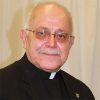Neither a trick question nor a trick answer. It’s Jesus’ Church. It says so right inside the Vatican, in Latin words circling Michelangelo’s cupola: “Tu es Petrus et super hanc petram aedificabo ecclesiam meam…” (Matthew 16:18) “You are Peter and upon this rock I will build MY church…” (Emphasis added.) This proved more literal than most people realize. Bones were discovered beneath St. Peter’s Basilica in 1942 and identified in 1968, so the church was indeed physically built on top of its eponymous pope.
The key takeaway is that from its inception, the Church belonged to Christ. It’s only when we, the Body of Christ, forget this essential fact that we get overwhelmed and despair of the current state of the Church.
We cannot deny that there are very serious problems that shouldn’t be minimized: Aftershocks of the 2002 sexual abuse of minors scandal continue to undermine people’s confidence in the bishops as well as in the institution. Lawsuits force bishops to sell church property. Political divisions have splintered parish councils. Fewer priestly vocations and increasingly aged priesthood have forced bishops into closing and consolidating hundreds of parishes. Discouraged parishioners either decrease their financial support or leave the Church altogether.
At times like this it helps not only to remind ourselves the Church belongs to Christ, but to look a bit more closely at our 2,000-year history. The Church has been through times of tribulation before. In fact, the first few hundred years saw brutal persecutions and martyrdoms unleashed by despots determined to blot out the new “Way.” Yet the Church endured and grew.
Internally the Church has been fraught with conflicts and divisions, including the Great Schism (split) of 1054 between Roman Catholicism and Eastern Orthodoxy.
During the darkest days, the Holy Spirit raised up saints to guide the Church into the light.
In medieval times when popes and bishops were living opulent lifestyles and corruption was rampant, Francis of Assisi heard Jesus speak to him from the cross: “Francis, rebuild my Church.” At first Francis took the message literally. He began to repair an abandoned chapel, one stone at a time. But eventually he realized his call was to be a living witness of Christ. He renounced all worldly possessions, devoting himself to preaching the Gospel and caring for the sick. He soon had a band of followers doing the same.
Closer to our own time, during the Great Depression, U.S. journalist Dorothy Day became a tireless advocate for the poor. (See Orbis Books preview) She founded the Catholic Worker Movement dedicated to offering hospitality to homeless people and protesting war, violence and all forms of injustice.
Day never hesitated to raise her voice against the wrongs she saw, even when it brought criticism on her from the Catholic hierarchy, as was the case regarding her pacifist stand during World War II. Yet she remained a loyal Catholic who sought her strength in the sacraments and rituals of the Church. Her cause for canonization is currently before the Vatican.
Passionate prophets like these call clergy and laity alike back to radical conversion to the Gospel.
Whose Church is it? It is Christ’s and it is ours. It will survive and thrive if we remember we belong to Christ and, like Francis of Assisi and Dorothy Day, we are called to be Christ in the world today. Let us keep in mind the rest of that quote from Matthew 16:18 inside St. Peter’s cupola: “And the gates of hell shall not prevail against it.”
Featured image: Parishioners at Our Lady of the Immaculate Conception Church in Taichung, Taiwan, fervently worship God at Sunday Mass in 2018. (Nile Sprague/Taiwan)
![]()

